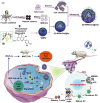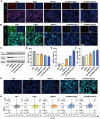Oxygen-Generating Biomimetic Nano-Herb System for Synergistic Therapy & Pain Relief in Triple-Negative Breast Cancer via HIF-1α/VEGF Pathway
- PMID: 40470112
- PMCID: PMC12136069
- DOI: 10.2147/IJN.S523754
Oxygen-Generating Biomimetic Nano-Herb System for Synergistic Therapy & Pain Relief in Triple-Negative Breast Cancer via HIF-1α/VEGF Pathway
Abstract
Purpose: This study aims to develop an innovative delivery system, (Q+M/MnOx)@Clip, to enhance the bioavailability and therapeutic efficacy of quercetin both in tumor treatment and pain alleviation.
Methods: The (Q+M/MnOx)@Clip system was evaluated to enhance the release of quercetin, investigate its ability to target cancer cells, alleviate tumor hypoxia, and improve the efficacy of chemodynamic therapy (CDT). Tumor hypoxia markers and immune response activation were assessed, along with the impact on pain relief biomarkers.
Results: (Q+M/MnOx)@Clip successfully mitigated tumor hypoxia, facilitated controlled Q release, and enhanced CDT in vitro and in vivo. The system demonstrated a dual therapeutic effect: anti-tumor immunity and significant cancer pain relief by reducing HIF-1α and VEGF-A levels.
Conclusion: The novel (Q+M/MnOx)@Clip system represents a promising advancement in nanomedicine, improving the bioavailability of quercetin and offering a more effective approach to cancer treatment by downregulation of HIF-1α and VEGF-A. This study demonstrates the potential for combining anti-tumor immunity with pain relief for triple-negative breast cancer therapy.
Keywords: biomimetic; cancer immunotherapy; chemodynamic therapy; oxygen generation; pain relief; quercetin.
© 2025 Cao et al.
Conflict of interest statement
The authors report no conflicts of interest in this work.
Figures









Similar articles
-
Ononin promotes radiosensitivity in lung cancer by inhibiting HIF-1α/VEGF pathway.Phytomedicine. 2024 Mar;125:155290. doi: 10.1016/j.phymed.2023.155290. Epub 2023 Dec 20. Phytomedicine. 2024. PMID: 38308918
-
Hypoxia inducible factor-1α/vascular endothelial growth factor signaling activation correlates with response to radiotherapy and its inhibition reduces hypoxia-induced angiogenesis in lung cancer.J Cell Biochem. 2018 Sep;119(9):7707-7718. doi: 10.1002/jcb.27120. Epub 2018 Jun 15. J Cell Biochem. 2018. PMID: 29904944
-
HIF-1α/GPER signaling mediates the expression of VEGF induced by hypoxia in breast cancer associated fibroblasts (CAFs).Breast Cancer Res. 2013;15(4):R64. doi: 10.1186/bcr3458. Breast Cancer Res. 2013. PMID: 23947803 Free PMC article.
-
Targeting hypoxia-inducible factor-1alpha: A new strategy for triple-negative breast cancer therapy.Biomed Pharmacother. 2022 Dec;156:113861. doi: 10.1016/j.biopha.2022.113861. Epub 2022 Oct 10. Biomed Pharmacother. 2022. PMID: 36228375 Review.
-
HIF-1α and VEGF Immunophenotypes as Potential Biomarkers in the Prognosis and Evaluation of Treatment Efficacy of Atherosclerosis: A Systematic Review of the Literature.Front Biosci (Landmark Ed). 2025 Jan 8;30(1):27004. doi: 10.31083/FBL27004. Front Biosci (Landmark Ed). 2025. PMID: 39862086
References
MeSH terms
Substances
LinkOut - more resources
Full Text Sources

